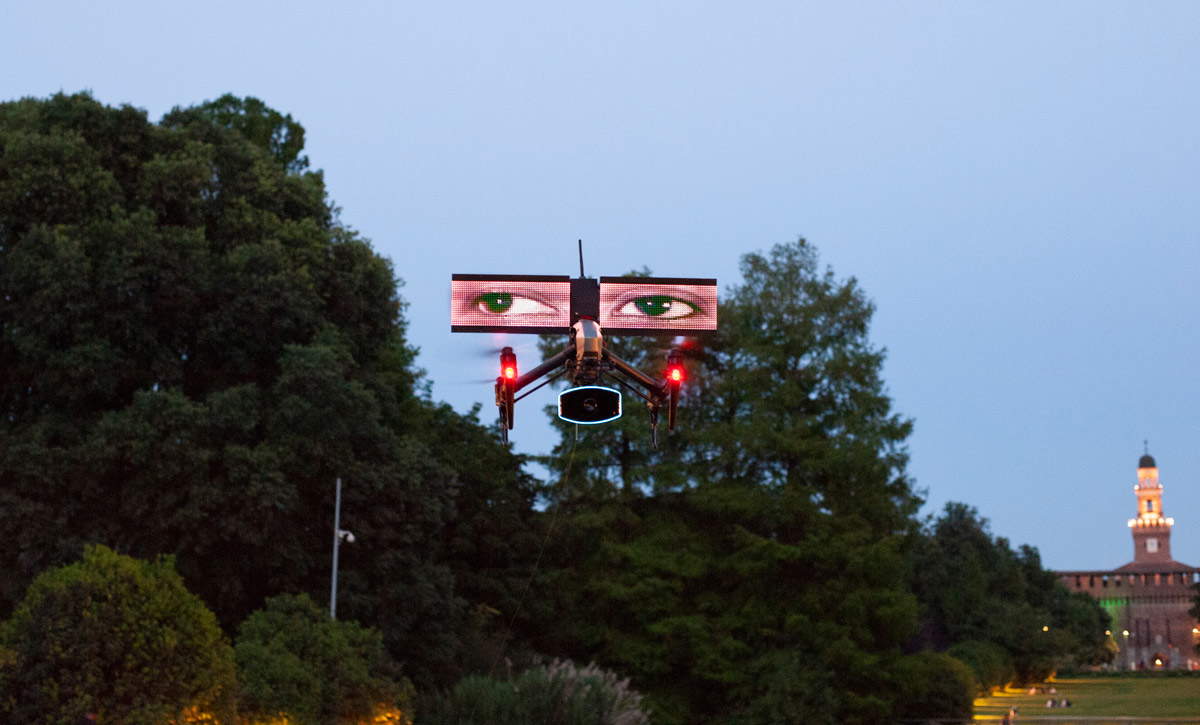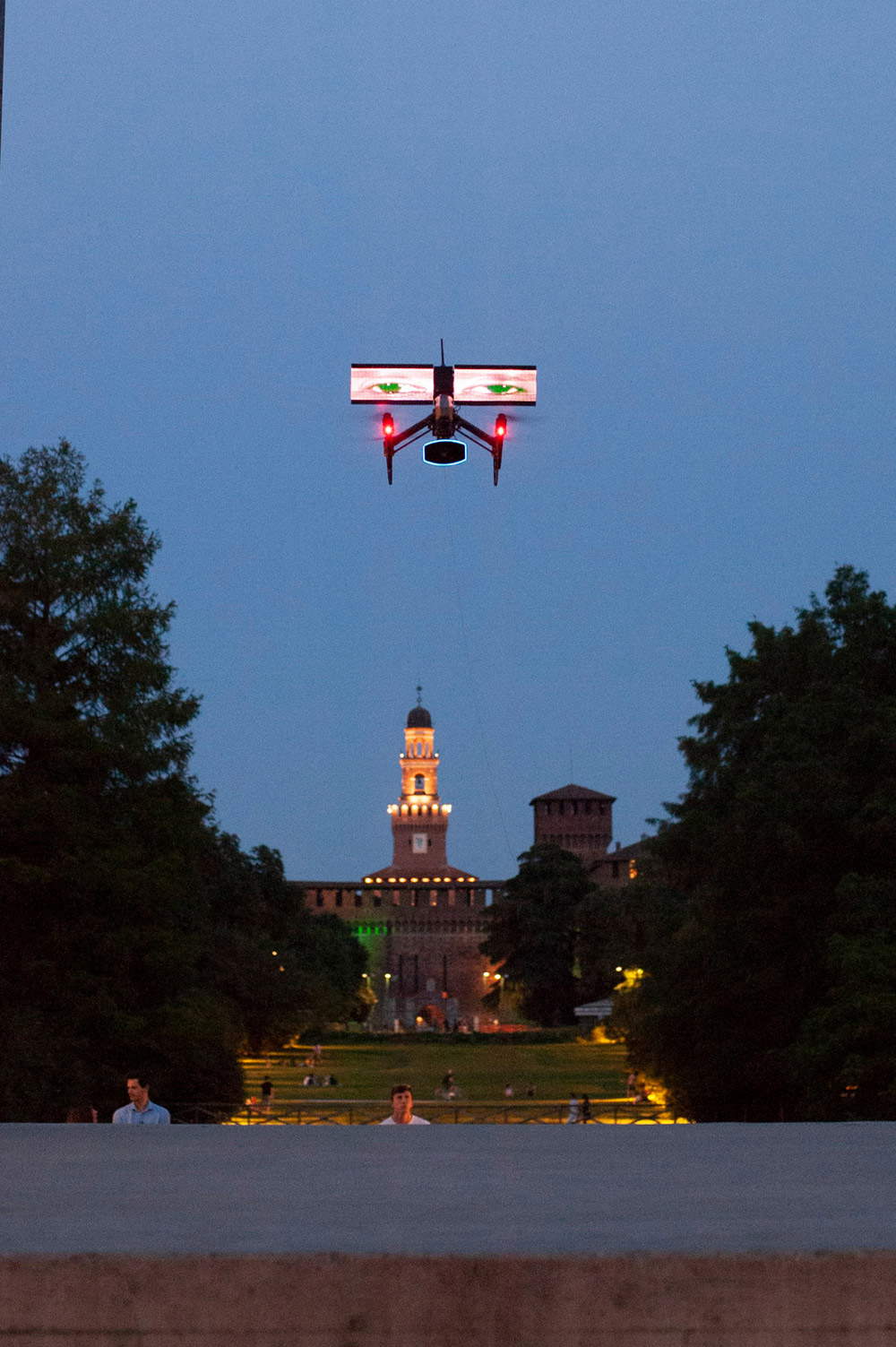In early June, Polish artist Krzysztof Wodiczko (Warsaw, 1943) presented, for the first time in Italy, in Milan, his project Loro (Them), at the same time an installation and a performance: Wodiczko “humanized” some drones by giving them a face and a voice. Specifically, these were the faces and voices of migrants, political refugees and marginalized people, telling their stories and points of view. The project aimed to start from the point of view of the so-called invisible to try to create the basis for dialogue and mutual understanding. We caught up with the artist and asked him a few questions about the project. The interview is edited by Federico Giannini, editor in chief of Finestre Sull’Arte.
 |
| Krzysztof Wodiczko during the performance Loro (Them) |
FG. Who are “Them”?
KW. The Them project introduces a mutation on a group of drones, which have undergone further transformations: they have been equipped with a pair of screens showing human eyes and with a speaker that transmits speech (and the speaker’s very shape resembles that of a mouth). With human eyes and mouth, the drone takes on the appearance of creatures that are part human and part machine. Refugees, too, are perceived by us as strange creatures somewhere between something and something else: partly familiar and partly unfamiliar, partly known and partly foreign, partly real and partly unreal, at one time “here and now,” and another time “there elsewhere,” suspended between their mother tongue and their new language, and between their lost land and the promised land. Living in this kind of limbo, refugees assume the status of a special species: at once natural and artificial. The project embraces and positively salutes the dialogicity of refugees and their disconnected identity. It acknowledges, disarms, and disperses in a performative and playful form the prejudices arising from fear and apprehension about refugees, seen as newcomers whose culture is not to be trusted and as transcultural beings. Refugees, these true survivors from the atrocities of war, can now take on the dual role of angels and agents who employ the typical technologies of aerial warfare to disseminate the truth of their testimony on earth, with the hope of stopping wars and the way wars continue and spread.
Where did the idea of putting a human face on a group of drones come from?
There is a connection that is culturally “genetic” between refugees, drones, and angels, and in particular there is a special connection with the figure of seraphim, the messengers with many wings who fly between heaven and earth and stand between ethics and politics. Drones and refugees may also share their appearance with another angelic host, that of the cherubim, whose young, winged eyes watch us from heaven to check our “standards” of innocence and love. With their invisible bodies and faces, the drones, who show themselves to us only with their eyes, and who have their lips replaced by megaphones, seem to be masked and protected from danger that might come from being recognized, from hostility toward them, from the fact that they could potentially be deported. Equipped to speak well disguised, they can safely share and broadcast from the sky the truth of their experience, and take the risk of looking boldly into our eyes.
With your “They (Them),” you have chosen an impressive mode of communication. However, how do you combine the need to speak to a wide audience and at the same time deepen the content?
Refugees “armed” with drones create, in a single moment, a scenario that is disturbing, entertaining, and also impossible. A scenario that also exaggerates to the point of making an absurd, almost comical, fear of those who fear that refugees are “invaders” or “foreign agents.” The Them Project hopes to disarm and perhaps dispel in the air, the seriousness and gravity of these fears.
Krzysztof Wodiczko is one of Poland’s leading living artists. He has always been concerned with the last and the marginalized through his art, and he is internationally famous for his works that exploit video projections on the facades of buildings and monuments (he has made more than ninety of them during his career, all over the world, from Italy to the United States, Germany to England, Mexico to Australia). Wodiczko has participated twice in the Venice Biennale (in 2009 he represented his country, Poland, in its national pavilion), twice in Documenta, and again in the Lyon Biennale, the Biennale of Sydney, the Whitney Biennial, the Yokohama Triennial, the Liverpool Biennale, and many other world-class exhibitions. In 2017, a major retrospective of his work was held at the Seoul Museum of Modern and Contemporary Art. His solo exhibitions have been held in museums around the world. He currently lives and works in New York and teaches at Harvard University’s School of Design.
Below are some images from Them (Them). Some excerpts from the performance can also be found on YouTube.
 |
| A moment from the performance Them (Them ) |
 |
| A moment from the performance Them (Them ) |
 |
| A moment from the performance Them (Them ) |
Warning: the translation into English of the original Italian article was created using automatic tools. We undertake to review all articles, but we do not guarantee the total absence of inaccuracies in the translation due to the program. You can find the original by clicking on the ITA button. If you find any mistake,please contact us.